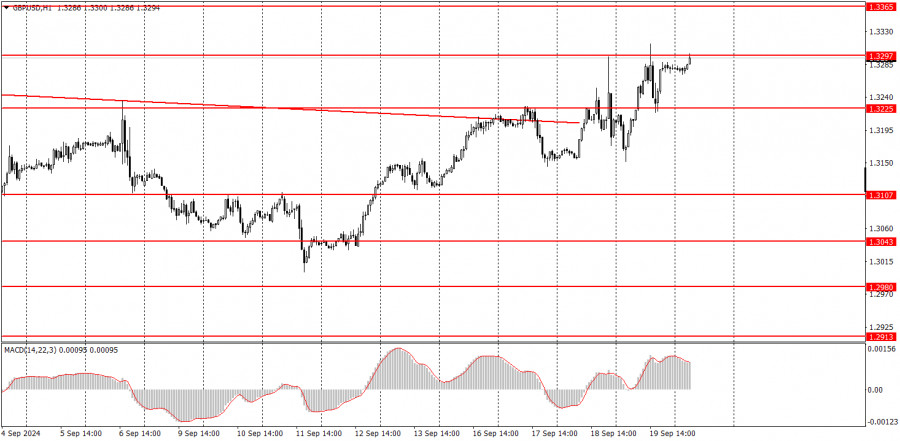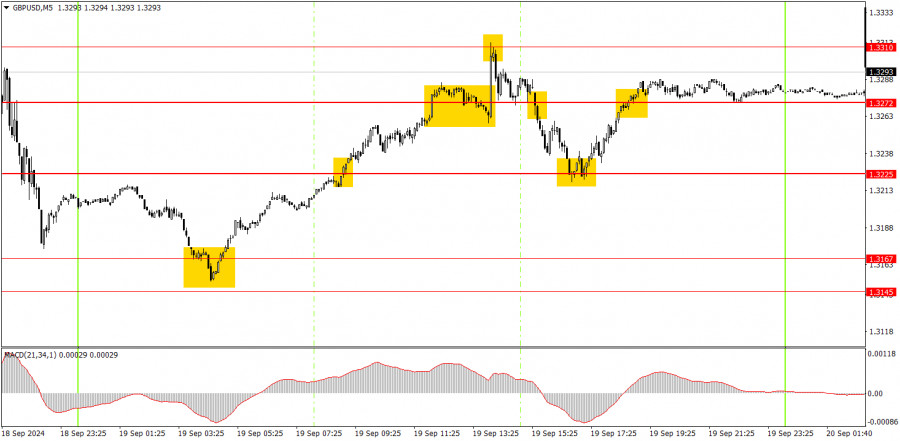Analysis of Thursday's Trades:
GBP/USD on 1H Chart
The GBP/USD pair sustained its upward movement on Thursday. Of course, one could once again conclude that the Federal Reserve meeting was the most dovish possible, while the Bank of England maintained a hawkish policy, which collectively triggered the dollar's new decline and the rise of the British currency. However, we continue to draw traders' attention to several important points.
First, the pound had risen throughout the week, even before the BoE and Fed meetings. This means the market had already priced in specific scenarios, which were then realized. In effect, the market reacted twice to the same events. Second, the pound has been rising for two years, even though the Fed has only just lowered its key rate for the first time. In our opinion, the current growth of the pair remains completely illogical. Of course, this doesn't mean that it can't continue. If major players continue buying the pound, regardless of anything else, the growth will persist. However, in that case, trading should be based solely on technical analysis. The fundamental and macroeconomic backgrounds are still being ignored.
GBP/USD on 5M Chart
On Thursday, many trading signals were generated in the 5-minute time frame as volatility reached almost 150 pips. However, trading under such conditions was very risky when the market was reacting to the two central bank meetings. Nevertheless, the signals were quite good.
At the start of the European trading session, the price consolidated above the 1.3225 level—this was a good point to open long positions. Later, the price reached the 1.3310 level and bounced off it precisely, and it was possible to open short positions. Subsequently, there was another precise bounce off the 1.3225 level—once again, long positions could be opened. So, all the signals turned out to be profitable and accurate, although novice traders might have missed some due to the high risk of price reversals influenced by the fundamental background.
How to Trade on Friday:
The GBP/USD pair has been "struggling" for several weeks, trying to correct at least slightly in the hourly time frame. It didn't succeed. As a result, the market decided it could first price in the BoE and Fed meetings in advance and then react again. Thus, the British pound is rising again, and the market continues to ignore the factors that support the dollar. How long this movement, which no one can explain, will continue is unknown.
On Friday, the British pound may sustain its upward movement. It doesn't need any reasons or justifications for this. Trading should now be based on technical factors, as fundamental and macroeconomic data currently do not influence pricing.
In the 5-minute time frame, you can currently trade around the levels of 1.2748, 1.2791-1.2798, 1.2848-1.2860, 1.2913, 1.2980-1.2993, 1.3043, 1.3102-1.3107, 1.3145-1.3167, 1.3225, 1.3272, 1.3310, 1.3365. On Friday, the only report in the UK will be the retail sales report. What can be expected from it? Its figure may be weak, the pound might fall by 20 pips, and the upward trend could resume. Or the pair may correct today, and then the uptrend will resume.
Basic Rules of the Trading System:
1) The strength of a signal is determined by the time it takes for the signal to form (bounce or level breakthrough). The less time it took, the stronger the signal.
2) If two or more trades were opened around any level due to false signals, subsequent signals from that level should be ignored.
3) In a flat market, any currency pair can form multiple false signals or none at all. In any case, it's better to stop trading at the first signs of a flat market.
4) Trades should be opened between the start of the European session and midway through the U.S. session. After this period, all trades must be closed manually.
5) In the hourly time frame, trades based on MACD signals are only advisable amidst good volatility and a trend confirmed by a trendline or trend channel.
6) If two levels are too close to each other (5 to 20 pips), they should be considered a support or resistance area.
7) After moving 20 pips in the intended direction, the Stop Loss should be set to break even.
What's on the Charts:
Support and Resistance price levels: targets for opening long or short positions. You can place Take Profit levels around them.
Red lines: channels or trend lines that depict the current trend and indicate the preferred trading direction.
The MACD indicator (14,22,3): encompassing both the histogram and signal line, acts as an auxiliary tool and can also be used as a source of signals.
Important speeches and reports (always noted in the news calendar) can profoundly influence the movement of a currency pair. Hence, trading during their release calls for heightened caution. It may be reasonable to exit the market to avoid sharp price reversals against the prevailing movement.
For beginners, it's important to remember that not every trade will yield profit. Developing a clear strategy and effective money management is key to success in trading over the long term.











